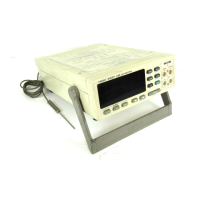.3.6 Data Formats
The 3227 uses the character string data and decimal numeric data, and the
type used varies according to the command in question.
(1) Character data
The character string data must always begin with an alphabetic character,
and the following characters can be either alphabetic character or numerals.
Although in character data either upper case letters or lower case letters are
accepted, response messages output by this unit are always in upper case
letters.
":HEADer OFF
"
(2) Decimal data
The numeric data values are all represented in decimal, in three formats
identified as NR1, NR2, and NR3, and each of these can appear as either a
signed number or an unsigned number. Unsigned numbers are taken as
positive.
Further, if the accuracy of a numeral value exceeds the range with which this
unit can deal, it is rounded off. (5 and above is rounded up; 4 and below is
rounded down.)
NR1 format integer data
Examples +12, -23, 34
NR2 format fixed point numbers
Examples +1.23, -23.45, 3.456
NR3 format floating point numbers
Examples +1.0E-2, -2.3E+4
The term "NRf format" includes all these three formats above.
When the 3227 is receiving it, accepts NRf format, but when it is sending
response messages it utilizes whichever one of the formats NR1 to NR3 is
indicated in the particular command.
All of the following examples set the resistance range to 300 Ω.
":RESIstance:RANGe 300"
":RESIstance:RANGe 299.2"
":RESIstance:RANGe 2.995E2"

